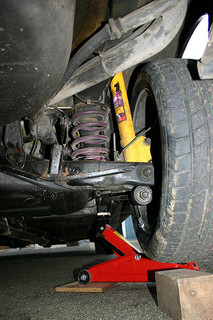
Photo credit: Jon Whitton on Flickr
A new group of workers is being warned about a well-known risk faced by miners and construction workers.
Alert: Asbestos Hazard in Vehicle Brake Repair describes auto mechanics’ risk of inhaling fine asbestos fibres while working with aftermarket replacement brake pads.
“Principal sources of asbestos exposure occur during the removal of dust from brake drums and assemblies and when linings are machined before installation,” reads the Alert.
It describes how asbestos was used in the past as “a friction material in brake linings, disc brake pads and clutch facings in vehicles because of its unique fire resistance and wear properties.”
Asbestos was phased out in Canada during the 1980s due to health effects coming to light, but according to Statistics Canada reports, more than $2.6 million worth of brake pads containing asbestos entered Canada in 2011, with more than half imported into Ontario, says Ontario’s Ministry of Labour, who posted a link to the Alert on Twitter, where they are @OntMinLabour.
“Asbestos is dangerous to work with and can cause occupational diseases, including respiratory problems, mesothelioma and lung cancer,” reads the Alert. “For each disease, there is a period of latency, from 10 to 40 or more years, between first exposure to asbestos and the appearance of the disease.”
Dealing with the hazard
According to the Alert, employers are recommended to use only “brake pads that do not contain asbestos. When ordering aftermarket replacement brake pads, check to confirm that the product identifies or confirms that it does not contain asbestos…Never assume a product is asbestos free unless it is stated either on the box/container or purchase invoice.”
I wanted to find out what mechanics were learning about this hazard so I got in touch with instructor Naleen Jit from the BCIT School of Transportation, who sent me a copy of the Automotive Service Technician Foundation Program Outline.
It’s published by the Industry Training Authority – the provincial training agency that “…works with employers, employees, industry, labour, training providers and government to issue credentials, manage apprenticeships, set program standards, and increase opportunities in the trades.”
The publication for automotive students includes OHS information on the WorkSafeBC Regulation, WHMIS, safe vehicle operation, safe work practices, and more. Naleen also described the sanctioned practice for working with brakes.
“When working with brakes, they use a brake parts washer to clean the components using a water solution which is collected and contained within the washer unit,” Naleen said via email. “They are reminded not to blow the brake dust with compressed air and are made aware about respirators that are available to prevent the inhalation of brake dust.”
See HiddenKiller.ca for more information on what to do if you are concerned about workplace exposures. You can always reduce your risk from here forward, no matter what you’ve done in the past.
Thanks to @OntMinLabour and Naleen at BCIT for sharing this information, which needs to get out there – so please pass it on.


